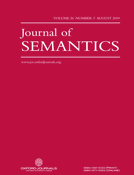-
Views
-
Cite
Cite
Alan C. Bale, David Barner, The Interpretation of Functional Heads: Using Comparatives to Explore the Mass/Count Distinction, Journal of Semantics, Volume 26, Issue 3, August 2009, Pages 217–252, https://doi.org/10.1093/jos/ffp003
Close - Share Icon Share
Abstract
Comparative judgments for mass and count nouns yield two generalizations. First, all words that can be used in both mass and count syntax (e.g. rock, string, apple, water) always denote individuals when used in count syntax but never when used in mass syntax (e.g. too many rocks v. too much rock). Second, some mass nouns denote individuals (e.g. furniture) while others do not (e.g. water). In this article, we show that no current theory of mass–count semantics can capture these two facts and argue for an alternative theory that can. We propose that lexical roots are not specified as mass or count. Rather, a root becomes a mass noun or count noun by combining with a functional head. Some roots have denotations with individuals while others do not. The count head is interpreted as a function that maps denotations without individuals to those with individuals. The mass head is interpreted as an identity function making the interpretation of a mass noun equivalent to the interpretation of the root. As a result, all count nouns have individuals in their denotation, whereas mass counterparts of count nouns do not. Also, some roots that have individuals in their denotations can be used as mass nouns to denote individuals.



